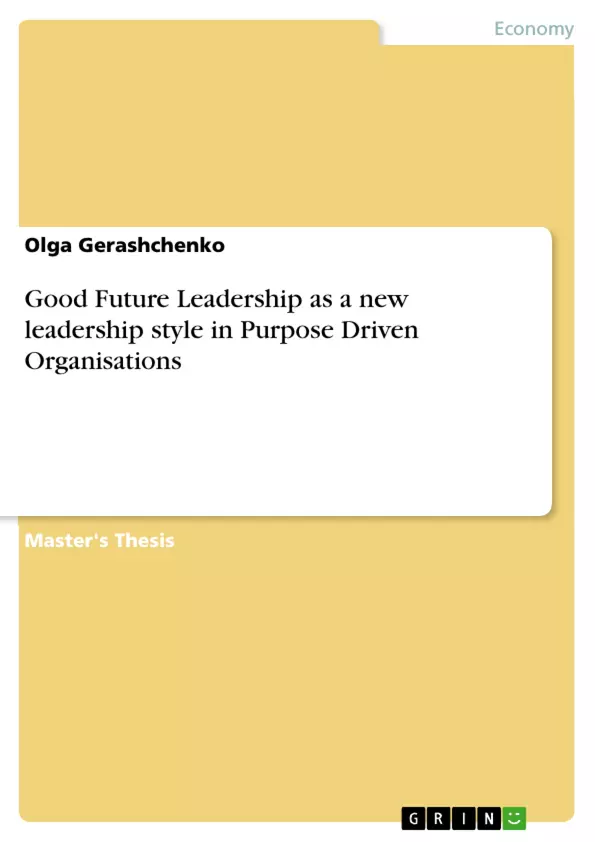Our working world is in a constant state of change. New forms of collaboration and mega trends such as digitalisation, but also the influence of the so-called VUCA world (Volatility, Uncertainty, Complexity, Ambiguity) are breaking through old structures. This is accompanied by social changes and new expectations of employees.
Olga Gerashchenko emphasises in her publication that meaning-oriented companies are more profitable and innovative and their employees are more motivated. But how does a company succeed in elaborating its own meaning and communicating it to all employees? What role do managers have to play in meaning orientation for themselves and, above all, for their employees? And what does that mean in concrete terms for everyday leadership?
Gerashchenko explains which competencies a manager must have in order to be able to lead his or her employees according to the meaning of a company. She shows how to develop a living culture in a team, but also in the entire company. She also makes clear how important authenticity is in this process. Her book is a helpful guide for Purpose Driven Organisations.
From the contents:
- Corporate Values;
- Corporate culture;
- Employee motivation;
- Employee retention;
- Leadership Style
Inhaltsverzeichnis (Table of Contents)
- Introduction
- Questions
- Structure of the paper
- Purpose/Meaning and its Meaning
- Purpose Driven Organisation: definition
- Terms purpose and meaning: Demarcation / Definition
- Purpose of the company
- What sense orientation is there for companies?
- Sense orientation, cultural change and Role of the leader in this process
- Relationship between meaning orientation and leadership role
- Culture and cultural change
- Role of the manager in cultural change
- New role of the manager in "Purpose Driven Organizations"
- Leadership styles with mention of meaning orientation
- Management-effective instruments in Purpose Driven Organisations
- Explanation of the need for a new approach
- Good Future Leadership (GFL)®: leading according to the meaning of the company
- Organization and meaning (sense as an orientation star)
- Sense of meaning in the workplace
- Competencies of the manager in Purpose Driven Organizations
- Self-guided tour: Behavior and competencies of the manager for self-leadership
- Behavior and competencies of the manager in employee management
- teamwork: Characteristics and competencies of the manager in teamwork
- organization: Behavior and competencies of the manager in relation to the organization
- methodology
- Summary
Zielsetzung und Themenschwerpunkte (Objectives and Key Themes)
This master's thesis explores the concept of "Purpose Driven Organizations" and how the search for meaning in companies influences leadership styles and management practices. The thesis aims to define and analyze the concept of purpose-driven organizations, investigate the relationship between meaning orientation and leadership roles, and introduce a new leadership style called "Good Future Leadership" (GFL®).- Defining and analyzing the concept of purpose-driven organizations
- Exploring the relationship between meaning orientation and leadership roles
- Introducing and analyzing the "Good Future Leadership" (GFL®) style
- Identifying key competencies for managers in purpose-driven organizations
- Analyzing the impact of cultural change on leadership and management practices
Zusammenfassung der Kapitel (Chapter Summaries)
- Introduction: This chapter introduces the changing landscape of the working world, highlighting the influence of factors such as the VUCA world and the growing importance of corporate social responsibility (CSR). It argues that companies are increasingly searching for meaning and purpose, leading to the emergence of the "Purpose Driven Organizations" concept.
- Purpose/Meaning and its Meaning: This chapter provides a comprehensive definition of "Purpose Driven Organisations" and delves into the terms "purpose" and "meaning," establishing a clear demarcation between them. It explores the importance of purpose for companies and examines the different sense orientations that exist for businesses.
- Sense orientation, cultural change and Role of the leader in this process: This chapter analyzes the relationship between meaning orientation and the role of leadership. It discusses the importance of cultural change in organizations and the role of managers in facilitating this change.
- New role of the manager in "Purpose Driven Organizations": This chapter examines the evolving role of managers in "Purpose Driven Organizations," including the need for new leadership styles and management tools. It emphasizes the importance of incorporating meaning orientation into leadership approaches.
- Good Future Leadership (GFL)®: leading according to the meaning of the company: This chapter introduces the "Good Future Leadership" (GFL®) style, a new leadership approach that emphasizes aligning leadership with the meaning and purpose of the company. It discusses the importance of organizational sense and meaning in the workplace.
- Competencies of the manager in Purpose Driven Organizations: This chapter outlines the key competencies required for managers in "Purpose Driven Organizations," focusing on self-leadership, employee management, teamwork, and organizational behavior.
Schlüsselwörter (Keywords)
This thesis focuses on the evolving role of leadership in today's business environment, with particular emphasis on the impact of purpose and meaning on organizations. The key topics covered include: purpose-driven organizations, meaning orientation, leadership styles, Good Future Leadership (GFL®), cultural change, management competencies, and employee engagement. The study explores the relationship between leadership and the search for meaning, analyzing the impact of purpose on organizational culture, management practices, and employee behavior.- Quote paper
- Olga Gerashchenko (Author), 2020, Good Future Leadership as a new leadership style in Purpose Driven Organisations, Munich, GRIN Verlag, https://www.grin.com/document/1187325



